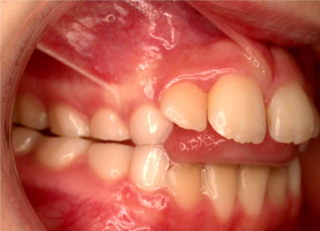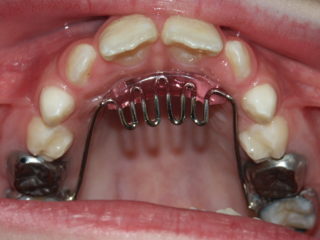What Is a Tongue-Thrust?
A tongue thrust, also called a reverse swallow or immature swallow, is best described as a swallowing pattern that pushes the tongue through the front teeth during swallowing. This is a result of an imbalance of the orofacial muscles. Unbeknownst to many, a tongue thrust is not THE problem. It is a symptom of the bigger concern incorrect oral rest posture.
There are several types. Anterior open bite is the most common type. It is characterized by front lips open with the tongue protruding past the lips. An anterior thrust occurs when the upper front teeth (anterior incisors) are protruded (“pushed out”) and the bottom lower teeth (mandibular incisors) are tilted backwards.

How To Fix / Stop
a Tongue Thrust?
There are some practitioners who place appliances in the mouth to prevent thrusting, but the truth is…the tongue thrust is a symptom of incorrect oral rest posture. Placing a “device” in the roof of the mouth actually creates yet another adaption that myofunctional therapists have to correct. The best long-term treatment is myofunctional therapy. This type of treatment focuses on the oral habit, the root cause, and teaches new habits through re-education of the muscles associated with swallowing. Awareness of the habit and learning a new way of functioning is important. Eventually, the appliance will be removed and the client goes right back to old habits because habit appliances only address the symptom, not the cause, and as I state earlier, they create new incorrect muscle function.

What Causes a Tongue Thrust?
Anything that alters the correct swallowing mechanics, is a tongue thrust. The cause…incorrect oral rest posture!
Thumb sucking results in an altered swallowing position because there is an obstacle in the way. When anything impedes the tongue from its normal swallowing pattern, the mouth adapts to the object resulting in a forward pushing motion of the tongue, (or a sideways motion). Even when the obstacle (thumb, finger, pacifier) is removed, the poor habits remain. Therefore, it is very important to stop the habit and complete myofunctional therapy at the same time.
Read Why a Former Thumb Sucker Still Needs MFT
Tongue-ties lead to a tongue thrust because the tongue can’t reach the roof of the mouth for correct swallowing. The tip of the tongue belongs behind, but not touching, the front teeth. The body of the tongue lines the roof of the mouth. Even when a tongue-tied patient can reach the tip of the tongue to the roof, they usually can’t get the middle and back of the tongue elevated. This is a physical barrier and until the barrier is removed, changing the habit can be impossible.
Read the Ultimate Guide to Tongue-Ties
Nasal congestion causes you to breathe through your mouth and have your mouth open at rest. When you mouth breathe, the tongue is not in the proper place (incorrect oral rest posture) and a reverse swallow occurs.
Read the Ultimate Guide to Breathing
Low resting tongue posture is when the resting tongue is found in the floor of the mouth, in contrast to the palate where it belongs. A low resting tongue posture combines with mouth breathing to create a thrust swallowing pattern. The tongue may push laterally or forward against the front teeth.
Read the Ultimate Guide to Orofacial Myofunctional Therapy
Here Are Some Blog Articles to Help You!
As your Myofunctional Educator Extraordinaire, I work tirelessly to put out valuable material for you!
Simply click on the text description for a quick link to the article!
What Is a Tongue Thrust?
In this weeks video, we dive into the topic of those pesky tongue thrusts. Many people think that a tongue thrust is the problem, but it is really a symptom of something else. Understanding what a tongue thrust is will help you uncover the bigger reason of why you have a tongue thrust.
Can Your Tongue Affect Orthodontic Treatment? Your Beautiful Smile Counts On Understanding What a Tongue Thrust Is
If you’ve had braces before, then I would bet you often wonder about this. I can testify that my darn tongue was the bane of all my orthodontic problems. It frustrated me so much to see how my swallow could affect orthodontic treatment.
If you have braces or have had them, a tongue thrust can be a pain in the butt for a couple of reasons:
- A tongue thrust will push around your nice, straight teeth knocking them out of alignment
- A tongue thrust will affect your orthodontic treatment by prolonging your time in braces. Your orthodontist will be trying to fix one problem and your swallow might continually create a new problem.
My Personal Story With a Tongue Thrust
My personal story with a tongue thrust was frustrating and rather expensive. In my case, that tongue thrust caused me to pay for braces not once but twice! It was on the third go-round that my kind and brilliant orthodontist suggested that I just complete myofunctional therapy rather than pay for braces again. The problem was my tongue thrust and because of my incorrect swallowing mechanics, my tongue was pushing my teeth around.
Learn from my personal story with a tongue thrust! My step by step approach to helping you learn the correct way to swallow is well organized, and meticulously put together just for you!
Understanding a Tongue Thrust
A tongue thrust is an incorrect swallow. The tongue comes forward and down instead of up and back. The consequences? Chewing, swallowing, digestive and ortho problems. It is easily corrected! A tongue thrust is near and dear to my heart because this is how I was introduced to myofunctional therapy because of my terrible tongue thrust!

